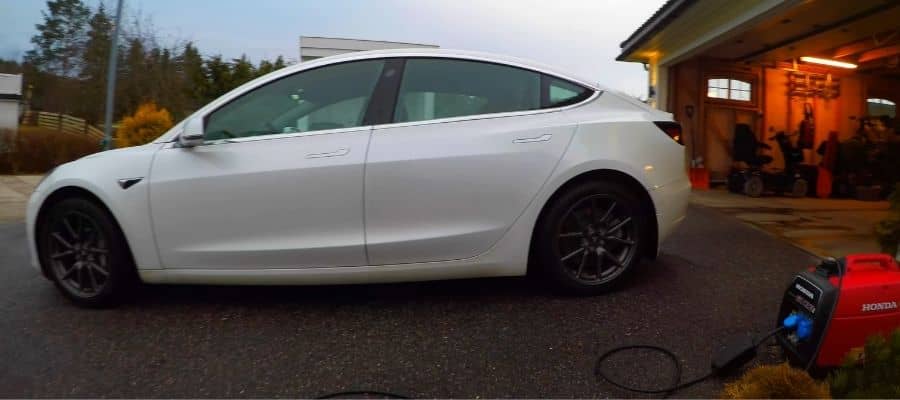
Yes, you can charge a tesla with a generator, but there are caveats.
In an emergency, it can be a safe and effective solution. Let’s say the power goes out throughout the house, and your car isn’t charged for any reason. Then you may use it to charge your car and power your home. Other instances in which you could find it useful to charge your electric car (EV) with a generator include:
- Being stuck at an off-grid campsite
- Conducting a ridiculous experiment
This, however, is not a realistic, logical, efficient, or clever method of charging your car. Tesla Motors even discourag3es you from doing so in their user manual.
Tesla’s official charging instructions state that a portable generator should not be used. You’d presumably still need to go around if the electricity went out. You’d still need to go home if you were vacationing in a distant place or camped off-grid.
A generator should not be your first choice for charging your Tesla, but there are times when you may need to utilize one. It’s also useful in instances where there isn’t a power supply nearby. Both of these arguments apply equally to charging your Tesla.
In the event of a power outage, a portable generator comes in handy as a backup power supply. Consider why you may utilize a generator in general. So, why would you want to use a gas-powered generator or dual-fuel generator as a charging source?
At first, look, using a generator to charge a Tesla is absurd. After all, the whole point of buying an electric vehicle like a Tesla is to avoid using gas, right? Many generators (especially with high THD) will not work, and there are a few things you must be aware of before using a generator in this unusual circumstance.
Outlets & Connectors
Different types of connectors are available for different Tesla models. The amount of power with which you can charge varies with the connector type.
Table 1. Max charge rate for different types of connectors for different Tesla model
| CONNECTOR TYPE | MAX. CHARGE RATE/ADDED RANGE PER HOUR |
|---|---|
| Tesla mobile connector | 3 kW or 18 km |
| Type 2 cable | Model S: 16.5 kW or 77 km |
| Model X: 16.5 kW or 69 km | |
| Model 3 : 11 kW or 65 km | |
| Tesla wall connector | Model S: 16.5 kW or 77 km |
| Model X: 16.5 kW or 69 km | |
| Model 3 : 11 kW or 65 km | |
| Tesla supercharger | Up to 250 kW or 1600 km |
NEMA 5-20, 14-30, and 14-50 outlets are common on portable generators. All of them will necessitate the purchase of a Tesla mobile NEMA adapter. These adapters are available through the Tesla Online Shop.
The majority of inverter generators only have NEMA 5-20 outlets, which are rated for a maximum of 120 V and 20 A, 2400 W. You’ll probably be able to get a few kilometers out of them to get to the nearest power station.
NEMA 14-30 outlets are less prevalent; however, they can also be found in many generators. They have a maximum voltage rating of 240 V and a current rating of 30 A, 7200 W. These will be capable of charging your vehicle.
NEMA 14-50 outlets are significantly less prevalent among inverter generators, but they may be a feasible option for recharging your automobile in the event of a blackout or when you need to recharge a considerable amount of your battery.
Because maximum wattage/mileage is presently not feasible with inverter generators, you will seldom achieve them when charging your Tesla using a portable generator. As a result, charge times will vary depending on mobile adapter generation, outlet, and Tesla models.
Power Requirements (Watts & Sine Wave)
To calculate watts, simply multiply volts by amps, so at 120 volts and 12 amps, which is roughly what the Tesla mobile connector uses, we’ll need one thousand four hundred and forty watts of power, so whatever we charge our Tesla with has to generate at least fourteen hundred and forty sustained watts.
So, you’ll want to use a generator with a decent amount of wattage, usually at least 1,500W. However, the generator must do a couple of specific things if it’s going to charge it all. First, it must have a clean sine wave, which means it must have clean, consistent power. Many cheaper generators have a modified sine wave, which simply won’t work.
Grounding
The neutral bond on many inverter generators is not sufficient and may cause issues with the Tesla. To solve this issue, we suggest either converting to a bonded neutral or try a so-called bonding plug.
What it does is utilize a little resistor to trick whatever you’re plugging into the device into thinking there’s a ground when there really isn’t, which seems a little shady, but it’s supposed to work.
If grounding is still a problem, the only solution is to ground your portable generator in an old-fashioned manner.
Portable Generators with Pure Sine Wave
Some examples of inverter generators that do have a pure sine wave output are
Charging Your Tesla with A Portable Generator
Grounding concerns impede charging an electric vehicle with a generator. The generator must first be warmed up before gradually increasing the amps. Because you’re using an inverter generator and, most likely, a NEMA 5-20R outlet, you’re limited to a recharge speed of 4 miles per hour, which happens to be close to the typical walking speed.
If you intend to use a backup generator for your electric vehicle, test it out numerous times ahead to ensure that it will actually operate.
To summarize, you can recharge your Tesla using a generator, but only a few inverter generators with a clean sine wave will work. You will almost certainly encounter grounding problems.



